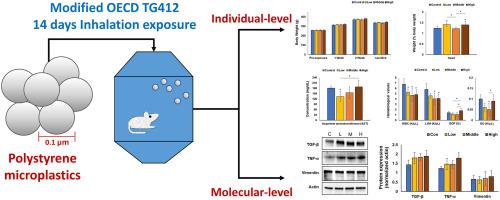Chemosphere ( IF 8.8 ) Pub Date : 2020-09-13 , DOI: 10.1016/j.chemosphere.2020.128330 Dongyoung Lim , Jaeseong Jeong , Kyung Seuk Song , Jae Hyuck Sung , Seung Min Oh , Jinhee Choi

|
Recently, there have been reports that many microplastics are found in the air, which has raised concerns about their toxicity. To date, however, only limited research has investigated the effects of micro(nano)plastics on human health, and even less the potential for inhalation toxicity. To fill this research gap, we investigated the potential inhalation toxicity of micro(nano)plastics using a modified OECD Guideline for Testing of Chemicals No. 412 ‘28-Day (subacute) inhalation toxicity study' using a whole-body inhalation system. Sprague-Dawley rats were exposed to three different exposure concentrations of polystyrene micro(nano)plastics (PSMPs), as well as control, for 14 days of inhalation exposure. After 14 days, alterations were observed on sevral endpoints in physiological, serum biochemical, hematological, and respiratory function markers measured on the samples exposed to PSMPs. However, no concentration-response relationships were observed, suggesting that these effects may not be definitively linked to exposure of PSMPs. On the other hand, the expression of inflammatory proteins (TGF-β and TNF-α) increased in the lung tissue in an exposure concentration-dependent manner. The overall results indicate that 14-day inhalation exposure of PSMPs to rats has a more pronounced effect at the molecular level than at the organismal one. These results suggest that if the exposure sustained, alterations at the molecular level may lead to subsequent alterations at the higher levels, and consequently, the health risks of inhalation exposed micro(nano)plastics should not be neglected.
中文翻译:

改性OECD TG 412对聚苯乙烯微(纳米)塑料的吸入毒性
最近,有报道说,在空气中发现了许多微塑料,这引起了人们对其毒性的关注。然而,迄今为止,只有很少的研究调查了微(纳米)塑料对人体健康的影响,甚至没有吸入毒性的潜力。为了填补这一研究空白,我们使用经改良的OECD 412号化学物质测试指南“ 28天(亚急性)吸入毒性研究”(使用全身吸入系统)研究了微(纳米)塑料的潜在吸入毒性。将Sprague-Dawley大鼠和对照组分别暴露于三种不同浓度的聚苯乙烯微(纳米)塑料(PSMPs),吸入暴露14天。14天后,在生理,血清生化,血液,在暴露于PSMP的样品上测得的呼吸和功能指标。但是,没有观察到浓度-反应关系,表明这些作用可能与PSMPs的暴露没有确定的联系。另一方面,肺组织中炎症蛋白(TGF-β和TNF-α)的表达以暴露浓度依赖性方式增加。总体结果表明,将PSMP吸入大鼠14天在分子水平上的影响比在机体上更为明显。这些结果表明,如果持续暴露,则在分子水平上的改变可能导致随后在更高水平上的改变,因此,不应忽视吸入暴露的微(纳米)塑料的健康风险。没有观察到浓度-反应关系,表明这些作用可能与PSMPs的暴露没有确定的联系。另一方面,肺组织中炎症蛋白(TGF-β和TNF-α)的表达以暴露浓度依赖性方式增加。总体结果表明,将PSMP吸入大鼠14天在分子水平上的影响比在机体上更为明显。这些结果表明,如果持续暴露,则在分子水平上的改变可能导致随后在更高水平上的改变,因此,不应忽视吸入暴露的微(纳米)塑料的健康风险。没有观察到浓度-反应关系,表明这些效应可能与PSMPs的暴露没有确定的联系。另一方面,肺组织中炎症蛋白(TGF-β和TNF-α)的表达以暴露浓度依赖性方式增加。总体结果表明,将PSMP吸入大鼠14天在分子水平上的影响比在机体上更为明显。这些结果表明,如果持续暴露,则在分子水平上的改变可能导致随后在更高水平上的改变,因此,不应忽视吸入暴露的微(纳米)塑料的健康风险。肺组织中炎症蛋白(TGF-β和TNF-α)的表达以暴露浓度依赖性方式增加。总体结果表明,将PSMP吸入大鼠14天在分子水平上的影响比在机体上更为明显。这些结果表明,如果持续暴露,则在分子水平上的改变可能导致随后在更高水平上的改变,因此,不应忽视吸入暴露的微(纳米)塑料的健康风险。肺组织中炎症蛋白(TGF-β和TNF-α)的表达以暴露浓度依赖性方式增加。总体结果表明,将PSMP吸入大鼠14天在分子水平上的影响比在机体上更为明显。这些结果表明,如果持续暴露,则在分子水平上的改变可能导致随后在更高水平上的改变,因此,不应忽视吸入暴露的微(纳米)塑料的健康风险。



























 京公网安备 11010802027423号
京公网安备 11010802027423号